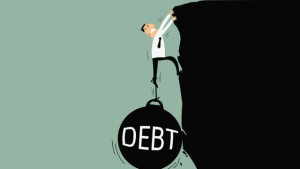Home » Commentary » Opinion » Borrowing binge raises the debt roof
· The Spectator - Flat White

 Scott Morrison returns to his desk this week with enthusiasm for company tax cuts reinforced by impressions gained from an overseas trip. But his attention will also be drawn back to the budget deficit as he faces the imminent prospect of needing to raise the Commonwealth debt ceiling.
Scott Morrison returns to his desk this week with enthusiasm for company tax cuts reinforced by impressions gained from an overseas trip. But his attention will also be drawn back to the budget deficit as he faces the imminent prospect of needing to raise the Commonwealth debt ceiling.
At least all he has to do now is write a letter to the Australian Office of Financial Management – the Treasury offshoot that manages Commonwealth debt. The action of his predecessor (with a little help from the Greens) in repealing the debt ceiling legislation three years ago has relieved Morrison of the more onerous task of steering an embarrassing debt bill through a fractious parliament.
There is a school of thought that a legislated debt ceiling helps force the government to balance the budget. I’m all for accountability and transparency, but I doubt a legislated debt ceiling makes much difference. If they can’t bring themselves to take the action needed to balance the budget, then they’re unlikely to be shamed into it by debt ceiling legislation. The debt is just a symptom of the underlying problem, which is failure to balance the budget. Succeed in doing that, and debt will stop rising.
Commonwealth gross debt stood at around $300 billion when the legislation was repealed and replaced with a Treasurer’s direction, which upped the ceiling to $500 billion. A few months later Hockey brought down his first budget, which had gross debt rising to $430 billion by June this year followed by balanced and surplus budgets as far as the eye could see. A ceiling of $500 billion looked adequate for many years to come.
The problem is that debt actually reached $420 billion last June and is set to approach $500 billion this June. How this happened is not a mystery. Deficits were much higher than Hockey’s budget projected, and in addition the Commonwealth has been borrowing heavily for off-budget adventures such as the NBN. The underlying cash deficit we hear so much about is $36.5 billion this year, but the headline deficit that includes NBN funding among other demands is in fact $52.5 billion, all of which needs to be borrowed.
The financial liabilities of the public sector don’t end with Commonwealth debt. The states have their own debt (around $140 billion in June 2016), as do their business enterprises (more than $100 billion), and all levels of government have huge unfunded public service superannuation liabilities.
It is true that Australia’s public debt — including the states — is lower (as a percentage of GDP) than that of most advanced countries. Many people draw too much comfort from that, as if the errors of other countries justify our own. There is no comfort to be drawn from the fact that the Commonwealth is borrowing heavily to finance recurrent expenditure. It is borrowing to pay salaries and social benefits. That makes no economic sense, whether or not Australia’s public debt is way below international norms. The lesson from the rising debt ceiling is that the budget must be balanced.
Robert Carling is a Senior Fellow at The Centre for Independent Studies
Borrowing binge raises the debt roof